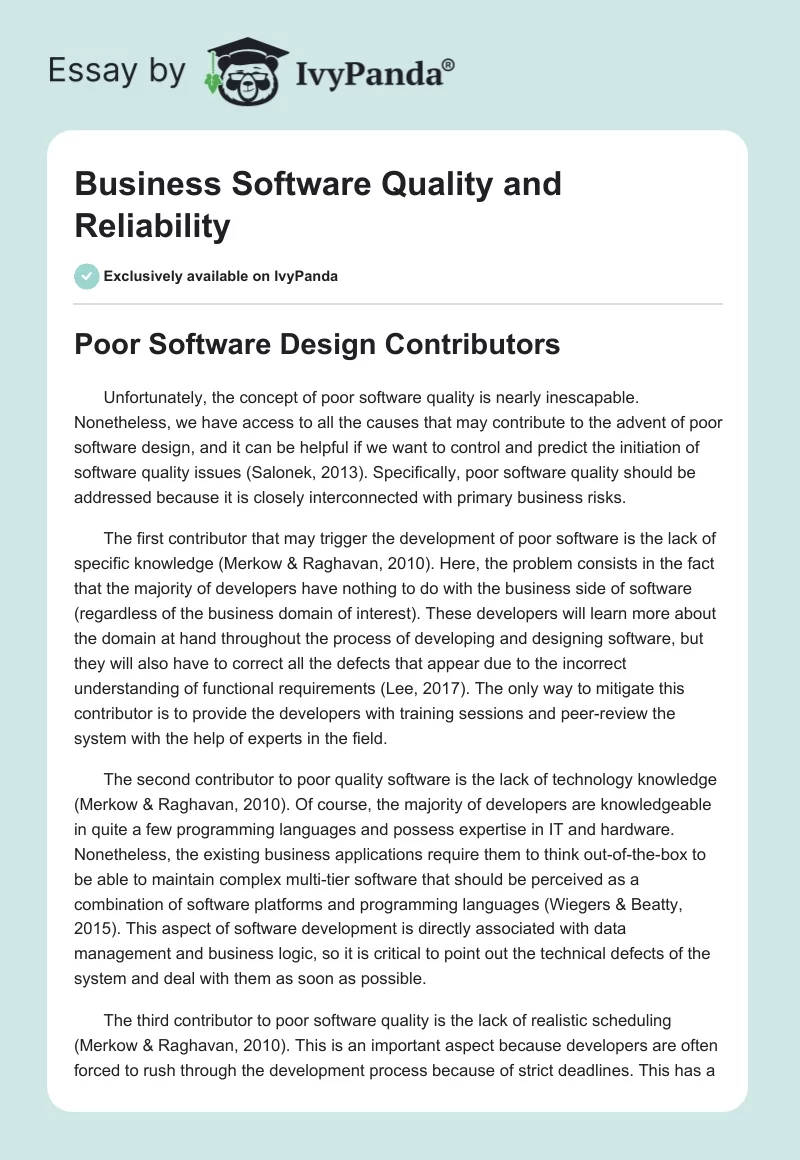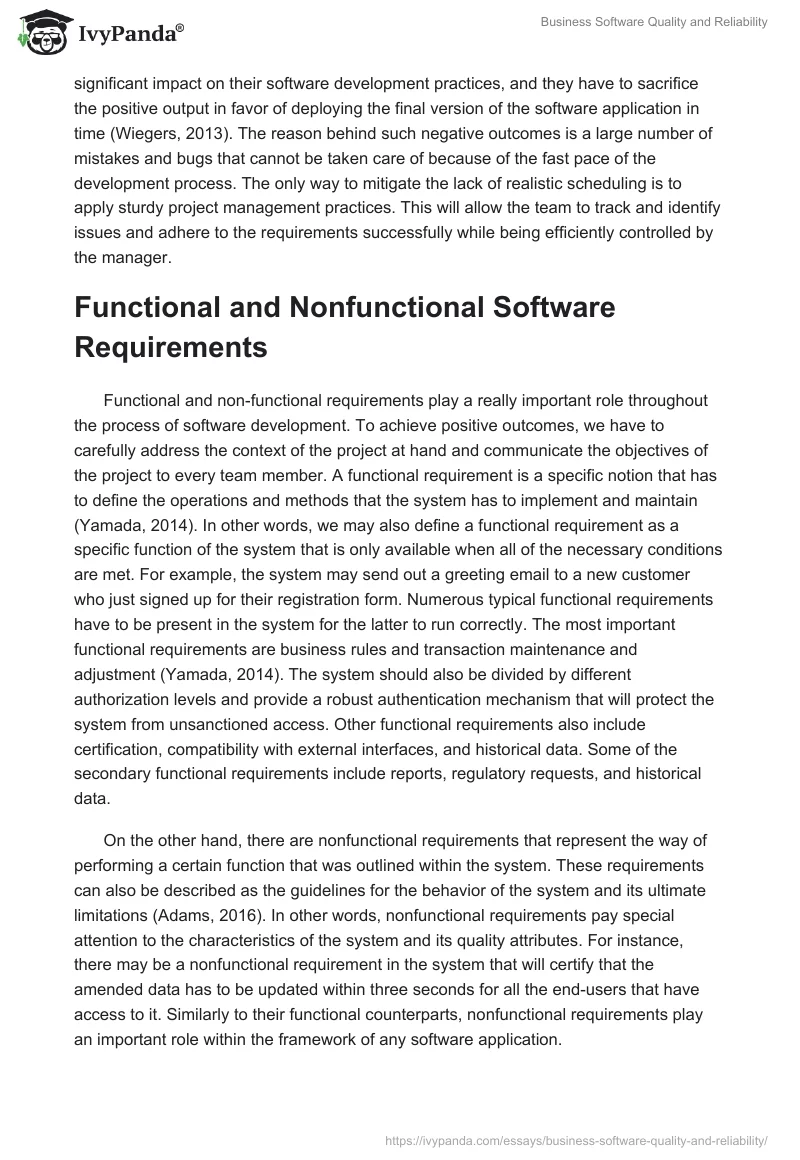Poor Software Design Contributors
Unfortunately, the concept of poor software quality is nearly inescapable. Nonetheless, we have access to all the causes that may contribute to the advent of poor software design, and it can be helpful if we want to control and predict the initiation of software quality issues (Salonek, 2013). Specifically, poor software quality should be addressed because it is closely interconnected with primary business risks.
The first contributor that may trigger the development of poor software is the lack of specific knowledge (Merkow & Raghavan, 2010). Here, the problem consists in the fact that the majority of developers have nothing to do with the business side of software (regardless of the business domain of interest). These developers will learn more about the domain at hand throughout the process of developing and designing software, but they will also have to correct all the defects that appear due to the incorrect understanding of functional requirements (Lee, 2017). The only way to mitigate this contributor is to provide the developers with training sessions and peer-review the system with the help of experts in the field.
The second contributor to poor quality software is the lack of technology knowledge (Merkow & Raghavan, 2010). Of course, the majority of developers are knowledgeable in quite a few programming languages and possess expertise in IT and hardware. Nonetheless, the existing business applications require them to think out-of-the-box to be able to maintain complex multi-tier software that should be perceived as a combination of software platforms and programming languages (Wiegers & Beatty, 2015). This aspect of software development is directly associated with data management and business logic, so it is critical to point out the technical defects of the system and deal with them as soon as possible.
The third contributor to poor software quality is the lack of realistic scheduling (Merkow & Raghavan, 2010). This is an important aspect because developers are often forced to rush through the development process because of strict deadlines. This has a significant impact on their software development practices, and they have to sacrifice the positive output in favor of deploying the final version of the software application in time (Wiegers, 2013). The reason behind such negative outcomes is a large number of mistakes and bugs that cannot be taken care of because of the fast pace of the development process. The only way to mitigate the lack of realistic scheduling is to apply sturdy project management practices. This will allow the team to track and identify issues and adhere to the requirements successfully while being efficiently controlled by the manager.
Functional and Nonfunctional Software Requirements
Functional and non-functional requirements play a really important role throughout the process of software development. To achieve positive outcomes, we have to carefully address the context of the project at hand and communicate the objectives of the project to every team member. A functional requirement is a specific notion that has to define the operations and methods that the system has to implement and maintain (Yamada, 2014). In other words, we may also define a functional requirement as a specific function of the system that is only available when all of the necessary conditions are met. For example, the system may send out a greeting email to a new customer who just signed up for their registration form. Numerous typical functional requirements have to be present in the system for the latter to run correctly. The most important functional requirements are business rules and transaction maintenance and adjustment (Yamada, 2014). The system should also be divided by different authorization levels and provide a robust authentication mechanism that will protect the system from unsanctioned access. Other functional requirements also include certification, compatibility with external interfaces, and historical data. Some of the secondary functional requirements include reports, regulatory requests, and historical data.
On the other hand, there are nonfunctional requirements that represent the way of performing a certain function that was outlined within the system. These requirements can also be described as the guidelines for the behavior of the system and its ultimate limitations (Adams, 2016). In other words, nonfunctional requirements pay special attention to the characteristics of the system and its quality attributes. For instance, there may be a nonfunctional requirement in the system that will certify that the amended data has to be updated within three seconds for all the end-users that have access to it. Similarly to their functional counterparts, nonfunctional requirements play an important role within the framework of any software application.
Some of the key requirements include performance, scalability, and availability. According to the nonfunctional view of software, an application should be reliable and recoverable by default (Pandey & Goyal, 2013). The concepts of security and maintenance are also central for decent software. To adhere to the basic guidelines of software development, the developers have to pay special attention to usability and data integrity within the application. The core idea behind the nonfunctional requirements is that they have to be approached thoughtfully because of their interconnection with the user experience. So as not to miss out on any important non-functional requirements, one should create a list of the most relevant requirements and implement them one by one.
References
Adams, K. (2016). Non-functional requirements in systems analysis and design. New York, NY: Springer.
Lee, R. Y. (2017). Software engineering: A hands-on approach. Hauppauge, NY: Nova Science.
Merkow, M. S., & Raghavan, L. (2010). Secure and resilient software development. Boca Raton, FL: CRC Press.
Pandey, A., & Goyal, N. (2013). Early software reliability prediction: A fuzzy logic approach. New Delhi, India: Springer.
Salonek, T. (2013). Top 15 worst computer software blunders. Web.
Wiegers, K. (2013). Creating a software engineering culture. Boston, MA: Addison-Wesley Professional.
Wiegers, K., & Beatty, J. (2015). Software requirements. Redmond, WA: Microsoft Press.
Yamada, S. (2014). Software reliability modeling: Fundamentals and applications. Tokyo, Japan: Springer.


